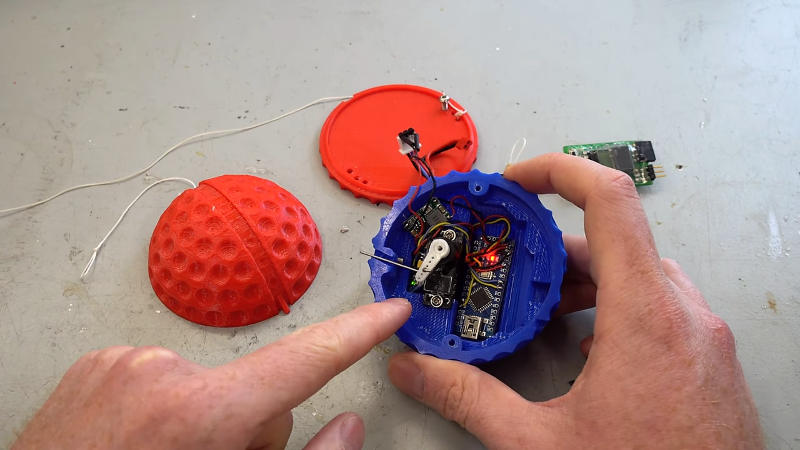What goes up must come down. And what goes way, way up can come down way, way too fast to survive the sudden stop. That’s why [Tom Stanton] built an altitude recording projectile into an oversized golf ball with parachute-controlled descent. Oh, and there’s a trebuchet too.
That’s a lot to unpack, but suffice it to say, all this stems from [Tom]’s obvious appreciation for physics. Where most of us would be satisfied with tossing a ball into the air and estimating the height to solve the classic kinematic equations from Physics 101, [Tom] decided that more extreme means were needed.
Having a compound trebuchet close at hand, a few simple mods were all it took to launch projectiles more or less straight up. The first payload was to be rocket-shaped, but that proved difficult to launch. So [Tom] 3D-printed an upsized golf ball and packed it with electronics to record the details of its brief ballistic flight. Aside from an altimeter, there’s a small servo controlled by an Arduino and an accelerometer. The servo retracts a pin holding the two halves of the ball together, allowing a parachute to deploy and return the package safely to Earth. The video below shows some pretty exciting launches, the best of which reached over 60 meters high.
The skies in the field behind [Tom]’s house are an exciting place. Between flying supercapacitors, reaction wheel drones, and low-altitude ISS flybys, there’s always something going on up there.
















A bunch of the energy is going into moving the whole trebuchet. I’ll bet that if you anchored it to the ground it would throw the ball a bit higher. You’ll still lose energy to the rotating masses in the trebuchet.
If I had a dog, I’d build a trebuchet. It would be a great way to clean up the yard…
Actually, the wheels reduce the amount of residual angular momentum imparted to the trebuchet counterweight. The trick is to optimise conversion of the potential energy in the counterweight to projectile kinetic energy without wasting too much on imparting rotating kinetic energy to the counterweight and arm. That is why counterweights are typically designed to hang from the arm, rather than being fixed to the arm.
Tom’s first version didn’t have wheels, but apparently, the performance improved after installing them. He did a nice investigation of this as well.
Link: https://www.youtube.com/watch?v=KpFTyE-wiNo
Let me rephrase what E’s saying, not because it’s wrong, just because there’s an easier way to say it :) The energy of the trebuchet comes from the dropping weight. To extract the most energy from a dropping weight, you want to get it to go as close to straight down as possible. The wheels allow the relatively lightweight frame to shift as the more massive weight drops giving it a closer to vertical drop.
There are some waay wackier modern takes on trebs that take this to absurdly extremes, the Merlin being the first one that comes to mind. It’s technically a trebuchet, but wacky as heck.
https://www.youtube.com/watch?v=WcNITnbkx_A&t=160s
Before we were married, I told my wife-to-be that I was going to build a kid-a-pult to launch our future offspring into the lake. Then I found out how flimsy kids are and abandoned my plans.
I also had this great plan to use helium balloons to make the kids almost neutrally buoyant so they could moonwalk around the yard. I realized that a slight miscalculation could result in a kid heading to the stratosphere. This would probably not end well.
Kids are fun, but they’re way more fun in theory than in practice.
You mean more accurate didn’t you?
Nope.
Why not just measure the time between the release of the ball and its hitting the ground?
In metric: h=1/2 * 9,81m/s³ * (t/2)²
You forgot to mention that you could use a 555 for that, instead of an arduino.